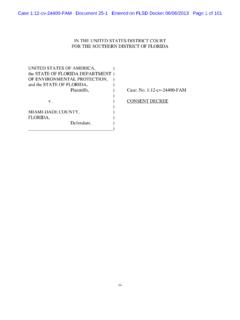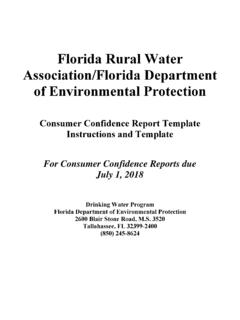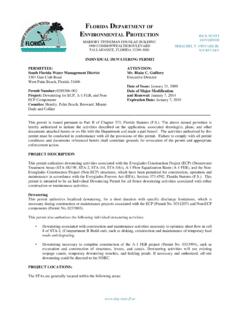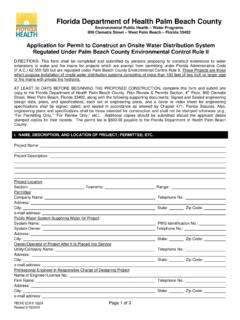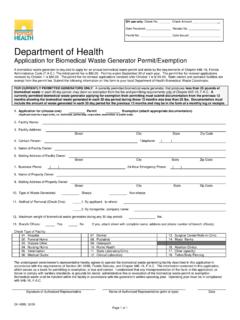Transcription of Florida Department of Environmental Protection Guidelines ...
1 Florida Department of Environmental ProtectionGuidelines to Conduct the Small Quantity Generator assessment , notification and verification Program September 2009 Florida Department of Environmental Protection 2 This manual provides Guidelines for conducting the Small Quantity Generator assessment , notification and verification Program to help ensure compliance with the program requirements established in Sections , , , , Florida Statutes ( ) Copies of these statutes can be found in the Appendix. Florida Department of Environmental Protection 3 Contents Introduction .. 4 Guidelines to Conduct the SQG assessment , notification and verification Program .. 6 Summary .. 6 Identify All Known and Potential generators in Your County .. 6 notification Procedures .. 8 verification Procedures .. 9 County Reporting Requirements.
2 10 Guide to Field Inspection .. 11 Inspector Training .. 11 Inspection Documentation .. 11 Preparing To Go Into the Field .. 12 Inspector Safety and Training .. 12 Conducting the Inspection .. 13 Compliance Assistance .. 16 Inspectors and Pollution Prevention (P2) .. 17 What to Do When You Get Back to the Office .. 18 Appendix .. 19 Applicable Florida Statutes .. 19 Sample notification Cover Letter and Fact Sheet .. 26 Sample County SQG ANV Program Inspection Form .. 29 SIC and NAICS Code Short List .. 33 File Specification Guide .. 41 Introduction .. 41 Data Submission Overview .. 42 Technical Specifications .. 43 Florida Department of Environmental Protection 4 Introduction Sections and , Florida Statutes ( ) establish a Small Quantity Generator assessment , notification and verification (SQG ANV Program).
3 A small quantity generator is defined in 40 Code of Federal Regulations (CFR) as a generator that produces less than 1,000 kilograms (or approximately 2,200 pounds or about 275 gallons) of hazardous waste in any calendar month. The Department of Environmental Protection (FDEP) has adopted federal regulations as state regulations in Chapter 62-730, Florida Administrative Code ( ) Part VI of the Water Quality Assurance Act of 1983 directed all counties in the State to complete a local hazardous waste management assessment and establish an assessment Roll which contains all known and potential SQGs in the county. Each year this list is updated to include any newly identified or potential SQGs. The assessment Roll and annual data updates are due on July 1 for all counties. Section , , requires that the SQG ANV Program be repeated every five years.
4 If a county declines to perform the local hazardous waste management assessment , the county shall make arrangements with its regional planning council (RPC) to perform the assessment . Under Sections and (16), , each county is required to initially notify all potential and known SQGs on the assessment roll, and to annually verify the waste management practices of at least 20% of the SQGs notified. SQGs verified in previous years would be excluded. Notifications are provided to all potential generators either by mail, by e-mail, at business license renewals, or during the on-site verification process. Verifications are made through on-site inspections of the facility. According to State hazardous waste regulations, all small quantity generators of hazardous waste are to manage their wastes in one or more of the following ways: Render the waste non-hazardous on-site.
5 Recycle or reuse the waste on-site or off-site. Store the waste according to State regulations. Ship the waste to a permitted hazardous waste management facility; or to a facility permitted, licensed, or registered by the State to manage industrial or municipal solid waste. Facilities ( landfills) that are permitted to manage municipal solid waste are prohibited from accepting hazardous unless approved by the State. Once the verification has been completed, the appropriate information is entered into FDEP s data management system called Small Quantity Generator Data Management System (SQGDMS). Additionally a cover letter summarizing the notification and Florida Department of Environmental Protection 5 verification program efforts is to be sent to FDEP s Hazardous Waste Regulation Section (HWRS) by July 1 of each year.
6 The cover letter shall include a summary of the information gathered to update county assessment data, newly identified SQGs, and the number of on-site verifications conducted. This process is repeated each year so that every known and potential SQG is inspected every five years. Under Section (17) , each county that implements the SQG ANV Program has the option to impose a surcharge of up to $50 on the business or occupational license or renewal of any firm that is identified as a small quantity generator of hazardous waste. A county may contract with or otherwise enter into an agreement with the county tax collector to collect the annual surcharge. The SQG assessment , notification and verification Program will result in: 1. Up-to-date identification of SQGs statewide. 2. Local hazardous waste management programs that complement state and federal efforts, through compliance and education efforts.
7 3. A statewide database on SQGs classified by the North American Industry Classification System (NAICS). 4. Improved management of hazardous waste, the Protection of public health and the county drinking water sources. 5. A better informed business and government community which can properly manage their hazardous waste. This will reduce their potential for civil and even criminal liability for hazardous waste violations 6. Dissemination of waste reduction technologies and information to help SQGs further reduce their generation of hazardous waste. Knowledge of hazardous materials and wastes stored at a business location, which can be useful for county departments responsible for comprehensive planning, emergency management, fire and police Protection , health care, local hazardous waste collection programs, and water quality management.
8 Florida Department of Environmental Protection 6 Guidelines to Conduct the SQG assessment , notification and verification Program Summary The SQG ANV Program consists of three parts, which are to be repeated every five years: 1. Identify all known and potential Small Quantity generators of Hazardous Waste (less than 1,000 kilograms per month) in your county and compile this information into a list called SQG assessment Roll. 2. Notify all SQGs on your assessment Roll and inform them of their legal responsibilities regarding proper waste management practices including pollution prevention (P2) options and opportunities. 3. Verify the waste management practices for each SQG identified on your assessment roll by conducting on-site inspections of 20% of the SQGs each year. Identify All Known and Potential generators in Your County Section , , directs all counties in the state to complete hazardous waste management assessments.
9 The SQG ANV Program works on a five year cycle. At the beginning of each five year cycle an assessment Roll containing all known and potential SQGs is established. Each year the assessment Roll is updated to include any newly identified or potential SQGs. The assessment Roll must be completed no later than on July 1. Updates are made yearly no later than July 1. A county must either perform the assessment itself or make arrangements with its regional planning council (RPC) to perform the assessment . FDEP will provide technical assistance to county governments and RPCs to ensure consistency in implementing the local hazardous waste management assessments. Each county or RPC shall contact FDEP during the preparation of the local assessment to receive technical assistance. Each county or RPC shall follow these Guidelines in order to properly implement these assessments.
10 The first step is to identify all known and potential small quantity generators of hazardous waste in the county. Potential generators include both private and public sectors. Step1: Develop a list of potential generators ( assessment Roll) For the purposes of the SQG ANV Program, businesses and government facilities are classified by appropriate North American Industry Classification System (NAICS) Florida Department of Environmental Protection 7 The NAICS code system provides a five and six-digit number for each industrial classification. A short list of NAICS code types most likely to generate hazardous waste can be found in the Appendix. Several sources may be used to identify potential generators of hazardous waste. Examples include: 1. The FDEP RCRA Handler list is a good source of businesses in your county that have received an EPA Identification Number.


